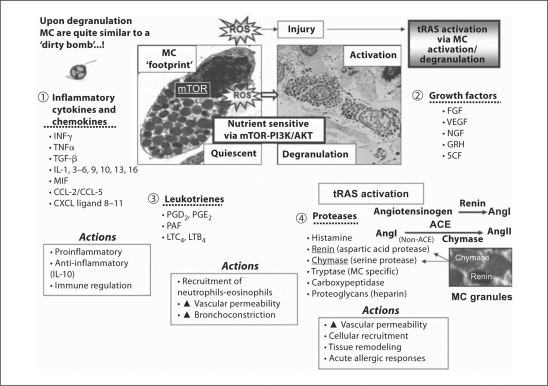Fig. 6.
Local injury to tissues due to ROS results in resident MC activation and degranulation: mediator release and actions. These events, in turn, may result in local tRAS activation resulting in local wound healing mechanisms and resultant tissue maladaptive remodeling with excessive fibrosis and scarring to the tissues with loss of function. Upon activation and degranulation the MC secretes and releases a plethora of active soluble mediators which include inflammatory cytokines and chemokines (1), growth factors (2), leukotrienes (3), and proteases (4). These mediators are responsible for numerous actions: inflammatory and immune regulation, cellular recruitment of inflammatory cells, increased vascular permeability, bronchoconstriction, acute allergic responses, and importantly cellular and ECM remodeling. Activation of tRAS via MC activation and degranulation allow for an increase in proteases, specifically the aspartic acid protease renin and the serine protease chymase, an enzyme important for the activation of a local tRAS, which in turn accelerates local tissue ECM accumulation, fibrosis, and scarring. AKT = Protein kinase B; CCL-2, -5 = C-C motif ligand; CXCL = C-X-C motif ligand; FGF = fibroblast growth factor; GMCST = granulocyte macrophage-colony stimulating factor; GRH = gonadotrophin-releasing hormone; INFγ = interferon γ; LTB4/LTC4 = leukotriene B4/C4; MIF = macrophage-inhibitory factor; mTOR = mammalian target of rapamycin; NGF = nerve growth factor; PAF = platelet-activating factor; PGD2/PGE2 = prostaglandin D2/E2; PI3K = phosphoinositide 3-kinase; SCF = stem cell factor; VEGF = vascular endothelial growth factor.

